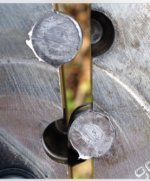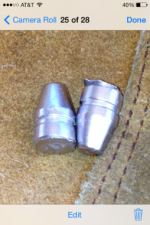After casting a few hundred bullets without a problem, in my last couple of sessions I've noticed while cutting off the sprue it is leaving a thin layer of lead that isn't being cut off of the base of the bullet. The blocks and underside of sprue plate appear to have no burrs. What's causing this problem?
You are using an out of date browser. It may not display this or other websites correctly.
You should upgrade or use an alternative browser.
You should upgrade or use an alternative browser.
356-120 TC mold
- Thread starter Swampman1
- Start date
Need a few good pictures to help. But I have had that problem occur after I got some lead up under the sprue plate around the hinge/screw. It formed a little lead "washer" that held the plate up a little higher than normal and it left a small gap that allowed the sprue not to be cut off flat with the base. Have you taken the plate completely off and checked around the screw and the top of the blocks in that corner?
'Just one idea.
'Just one idea.
Yeah I looked at that too. Everything looked clean. What I did do however, is I backed off on my pour flow-it looked a little too fast. Don't ask me why, but that made a big difference. Although it still has a little "runover". Here are a couple of pics.
Attachments
I took my 9 and my newer Lee 45 molds outdoors where I could see light between the sprue plate and blocks through both, and the 9 mold was definitely showing light through it, while the newer 45 mold shows just a sliver of light. I'm fairly careful not to overheat the molds while pouring. Dunno.
I had a couple that showed a similar "skirting" on them and they were Lee molds.
What I did that helped was to remove the sprue plate, and then take a good bench stone and using the smooth side I cleaned up the bottom side of the plate. I didn't get overly aggressive with it, but simply let the weight of the stone do the work.
I put a couple of pieces of that blue masking tape down on a piece of 1x4, and then laid the plat on top. The tape had enough friction to the outside that the plate was held in place really well. Then I added a drop or two of light machine oil and started doing the figure 8 on top. It immediately showed areas which were high, and I kept at it until most of the plate showed at least the light marks of where the stone rubbed. Like I said I only used the weight of the stone, and didn't put much if any pressure on it. I didn't want to take a chance of hitting one side or end more than the others.
When I was done with the plate, I cleaned the stone up, then did the same thing to the top of the blocks. Same thing, only using the weight of the stone to do the polishing.
When done I cleaned everything up using brake cleaner and reassembled did a couple of heat up and cool downs, and repeated spray with the brake cleaner, just to be sure I had the oil out of everything.
I relubed the pivot points and the plate up under the screw with some Bullplate, and the next time I had the pot up to temp I poured a few through them and no more tail fins.
Sometimes what I have seen with the Lee molds, especially the 6 cavity ones, is that the sprue plate is a bit concave, higher in the middle. I figure that this is from being stamped out rather than being cut, but I don't know for sure how they make them. I DO know that if you take one that is brand new, and use the stone on it, that it will clean up just about, if not, all the way around the edges, before you ever get to the center portion. That is what gives the the idea they have been stamped out.
Hope this helps.
What I did that helped was to remove the sprue plate, and then take a good bench stone and using the smooth side I cleaned up the bottom side of the plate. I didn't get overly aggressive with it, but simply let the weight of the stone do the work.
I put a couple of pieces of that blue masking tape down on a piece of 1x4, and then laid the plat on top. The tape had enough friction to the outside that the plate was held in place really well. Then I added a drop or two of light machine oil and started doing the figure 8 on top. It immediately showed areas which were high, and I kept at it until most of the plate showed at least the light marks of where the stone rubbed. Like I said I only used the weight of the stone, and didn't put much if any pressure on it. I didn't want to take a chance of hitting one side or end more than the others.
When I was done with the plate, I cleaned the stone up, then did the same thing to the top of the blocks. Same thing, only using the weight of the stone to do the polishing.
When done I cleaned everything up using brake cleaner and reassembled did a couple of heat up and cool downs, and repeated spray with the brake cleaner, just to be sure I had the oil out of everything.
I relubed the pivot points and the plate up under the screw with some Bullplate, and the next time I had the pot up to temp I poured a few through them and no more tail fins.
Sometimes what I have seen with the Lee molds, especially the 6 cavity ones, is that the sprue plate is a bit concave, higher in the middle. I figure that this is from being stamped out rather than being cut, but I don't know for sure how they make them. I DO know that if you take one that is brand new, and use the stone on it, that it will clean up just about, if not, all the way around the edges, before you ever get to the center portion. That is what gives the the idea they have been stamped out.
Hope this helps.
Thanks Mike, if I get the chance today I'll try that. As I said earlier, when I dropped the rate of flow, it got better. I'm assuming that's because the faster flow was actually pushing lead into the gap more than the slower stream is. Nonetheless, I will try to get it right.
chris in va
New member
Melt is too hot, pouring too much and cutting sprue too fast.
You basically want just a small button sized sprue to form, and watch the center. You'll see a slight dimple form as its frosting over, then you know it's ready. Be patient.
You basically want just a small button sized sprue to form, and watch the center. You'll see a slight dimple form as its frosting over, then you know it's ready. Be patient.
totalloser
New member
It's probably the way you are holding the mold. I'm guessing you have a six cavity. If you hold it with your hand around all three handles, it puts pressure on the sprue plate so that the wave washers are unable to keep the sprue plate flat on the mold.
IMO the best fix is to cut the sprue plate handle shorter so that you can get your hands around the mold handles without the sprue handle in the way.
If it still does it, I'd take a close look at the wave washers on the sprue pins- one on the pivot and one on the u-shape. If spring steel gets hot enough long enough it can anneal (unlikely) or perhaps they are gunked up and binding not doing their job correctly.
IMO the best fix is to cut the sprue plate handle shorter so that you can get your hands around the mold handles without the sprue handle in the way.
If it still does it, I'd take a close look at the wave washers on the sprue pins- one on the pivot and one on the u-shape. If spring steel gets hot enough long enough it can anneal (unlikely) or perhaps they are gunked up and binding not doing their job correctly.


